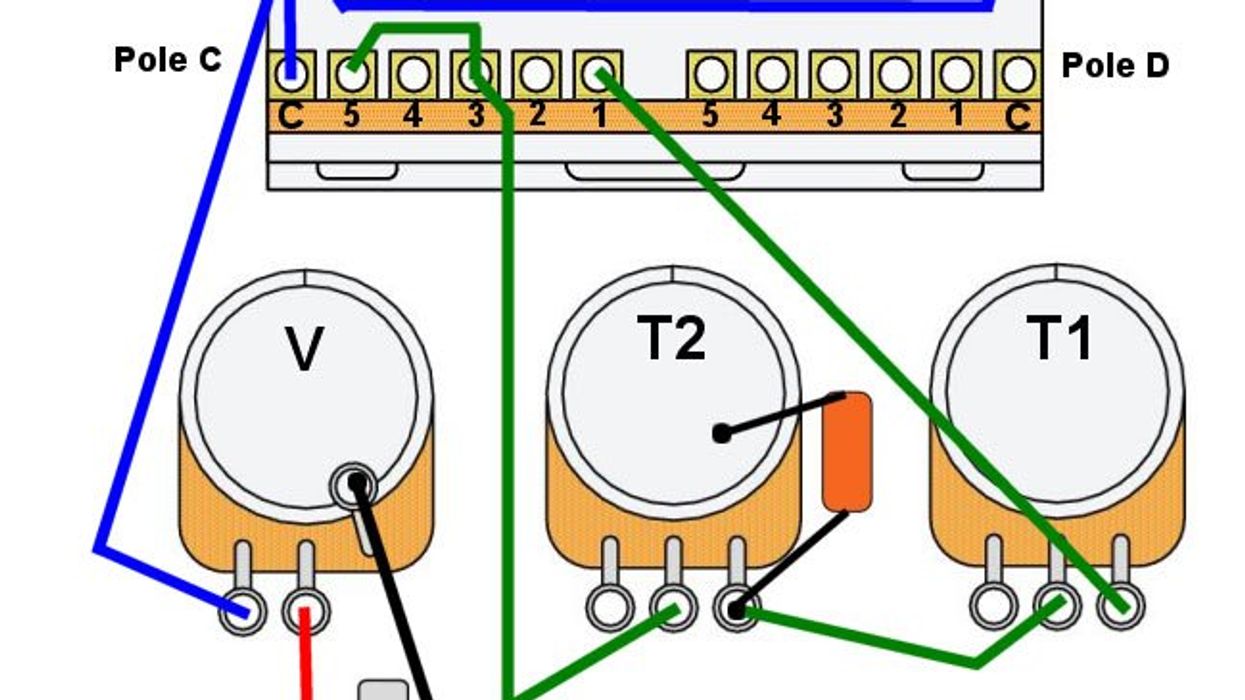Hello and welcome back to Mod Garage. This month, we’ll have a look at the Scott Henderson Strat-style wiring and what it means to bypass the tone control for certain pickup-switching positions.
Bypassing the tone control in a guitar circuit has become popular in recent years, so let’s explore how to do it. We’ve discussed this before in the context of using no-load pots for the tone control. A no-load pot will be electrically out of the circuit when it’s fully opened, so the pot is no longer part of the wiring, and will add no load to the circuit. This way you will have no high-end dampening and the tone is a tad louder, which can be a good thing or not, depending on your personal preferences.
This works great but requires that you open the tone pot(s) if you want this very direct sound. Some players like to have a kind of preset without tone control so there is no additional action they have to take. So, the basic idea of bypassing the tone controls is to transfer it to the pickup-selector switch rather than using no-load pots. There’s no law against combining this mod with no-load pots for the tone control, so you still have the opportunity to use it for sounds where the tone control is engaged.
The credits for this wiring are given to John Suhr, but it’s unknown if he came up with this special wiring during his time as a Senior Master Builder in the Fender Custom Shop, or later, after he started his own business in 1997.
The preset idea is not a new one. Fender has used it since the early ’50s, and the basic idea behind it is still the same. Imagine the following scenario: You’re playing the bridge pickup on your guitar with the corresponding tone pot set to 7 to add some warmth to your tone. In the middle of a song, you need to switch to another pickup that is connected to the same tone pot, but you need the tone pot fully opened to cut through the mix with this pickup setting. Two steps are required now: You need to switch to the desired pickup position, and you need to open the tone pot. Wouldn’t it be nice to have this happen by only dialing in the other pickup position? This is exactly the idea behind bypassing the tone control.
To illustrate, I chose the personal S-style wiring of the award-winning fusion, jazz, and blues guitarist Scott Henderson. The credits for this wiring are given to John Suhr, but it’s unknown if he came up with this special wiring during his time as a senior master builder in the Fender Custom Shop, or later, after he started his own business in 1997.
Henderson is best known for his solo work but also for his band Tribal Tech, as well as for playing with Chick Corea and the Zawinul Syndicate. Henderson released his first solo album, Dog Party, in 1994 and has six solo albums to date. He’s also a teacher at the Guitar Institute of Technology, now known as the Musicians Institute in Hollywood, California. His signature S-style guitar is built by the Suhr company. Henderson and John Suhr got to know each other while Suhr was still working at the Fender Custom Shop, and Henderson became one of the first endorsers for Suhr Guitars.
Henderson wanted an exclusive tone control for the bridge pickup and full clarity in the two in-between pickup positions, so this wiring is exactly what he was looking for.
Henderson’s personal wiring is basically a standard Stratocaster wiring you all know:
- bridge pickup alone
- bridge and middle pickup together in parallel
- middle pickup alone
- middle and neck pickup together in parallel
- neck pickup alone
What makes this wiring special is that the two tone controls are freely assigned, and the tone control is bypassed in the two in-between positions. So, the switching matrix for the Henderson wiring goes like this:
- bridge pickup alone with tone control #1
- bridge and middle pickup together in parallel with no tone control
- middle pickup alone with tone control #2
- middle and neck pickup together in parallel with no tone control
- neck pickup alone with tone control #2
Henderson wanted an exclusive tone control for the bridge pickup and full clarity in the two in-between pickup positions, so this wiring is exactly what he was looking for. Another benefit is that the bypass of the tone controls for the in-between positions is slightly compensating for the little volume loss, which is the nature of the (passive) beast when you combine two pickups in parallel.
In a Strat with two tone controls, changing the standard 5-way pickup selector switch for a 5-way super-switch is mandatory because you can’t do all this with only two switching stages. We don’t need all four switching stages of the 5-way super-switch, so one stage will stay unconnected.
Technically, these are 4P5T wafer switches, and they’re available as open frame as well as PCB-based versions. These switches are physically a lot larger than the standard ones, so depending on what guitar you have, you can run into massive problems to make them fit without rerouting your electronic compartment. Always check this before you buy such a switch to avoid any unpleasant surprises. To make the open version from Fender fit, you need at least 21 mm of space for the switch, but it’s better to have 25 mm to avoid any problems with the soldering terminals.
So here it is, the Henderson wiring as seen in Fig. 1. This wiring uses three 250k pots, a 0.047 µF tone cap, and no treble-bleed network on the volume pot.
That’s it for now. Next month, we’ll continue the tone-pot-bypass journey by looking at a Telecaster wiring, so stay tuned.
Until then ... keep on modding!





































